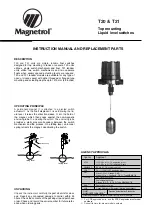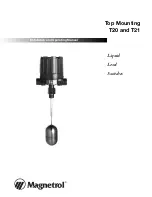
Rockwell Automation Publication 1783-UM007F-EN-P - September 2016
23
About the Switches
Chapter 1
Table 3 - Hardware Features for Stratix 5400, Stratix 5700, ArmorStratix 5700, and Stratix 8000/8300 Switches
Feature
Description
Power and relay connectors
You connect the power and alarm signals to the front panel of a switch:
• Stratix 5400 switches—One connector provides primary DC power. A second connector provides secondary power. The two connectors are
physically identical. You can activate alarms for environmental, power supply, and port status alarm conditions. You can configure an alarm
to indicate open or closed contacts. There is no separate power connector for PoE.
• Stratix 5700 switches—One connector provides primary DC power and a second connector provides secondary power. The two connectors
are physically identical. You can activate alarms for environmental, power supply, and port status alarm conditions. You can configure an
alarm to indicate open or closed contacts. A separate power connector is required for PoE.
• ArmorStratix 5700 switches—One cable provides DC power from one or dual power sources. Relay connectors and alarm relays are
available for only catalog numbers 1783-ZMS4T4E2TGP, 1783-ZMS8T8E2TGP, 1783-ZMS4T4E2TGN, and 1783-ZMS8T8E2TGN. There is no
separate power connector for PoE.
• Stratix 8000/8300 switches—One connector provides primary DC power (supply A) and the major alarm signal. A second connector
provides secondary power (supply B) and the minor alarm signal. The two connectors are physically identical and are in the upper-left side
of the front panel.
The power and relay connectors also provide an interface for two independent alarm relays: the major alarm and the minor alarm. You can
activate the relays for environmental, power supply, and port status alarm conditions. You can configure an alarm to indicate open or closed
contacts. The relay itself is normally open, so under power failure conditions, the contacts are open. From the Command-line interface (CLI),
you can associate any alarm condition with one alarm relay or with both relays.
When dual power sources are operational for any of the switches, the switch draws power from the DC source with the higher voltage. If one of
the two power sources fail, the other continues to power the switch.
Console port
To configure, monitor, and manage a switch, you can connect a switch to a computer through the console port:
• Stratix 5400 and Stratix 5700 switches—Connect to the console port with an RJ45-to-DB-9 adapter cable or a mini USB cable. The mini USB
driver is available in the firmware download section at
http://www.rockwellautomation.com
.
• ArmorStratix 5700 switches— Connect to the console port with an M12-to-DB-9 cable. See
• Stratix 8000/8300 switches—Connect to the console port with an RJ45-to-DB-9 adapter cable.
Dual-purpose (combo)
uplink ports
You can configure the dual-purpose uplink ports available on some models for RJ45 (copper) or SFP (fiber) media types. Only one of these
connections in each of the dual-purpose ports can be active at a time. If both ports are connected, the SFP module port has priority.
You can set the copper RJ45 ports to operate at 10 Mbps, 100 Mbps, or 1000 Mbps, full-duplex, or half-duplex. You can configure them as fixed
10 Mbps, 100 Mbps, or 1000 Mbps (Gigabit) Ethernet ports and can configure the duplex setting. 1000 Mbps is not supported on all modules
with combo ports.
You can use approved Gigabit (or 100 Mbps) Ethernet SFP modules to establish fiber-optic connections to other devices. These transceiver
modules are field-replaceable and provide the uplink interfaces when inserted into an SFP module slot. You use fiber-optic cables with LC
connectors to connect to a fiber-optic SFP module. These ports operate only in full-duplex.
10/100 copper ports
You can set the 10/100 copper ports to operate at 10 Mbps or 100 Mbps, full-duplex, or half-duplex. You can also set these ports for speed and
duplex autonegotiation in compliance with IEEE 802.3-2002. The default setting is autonegotiate.
When set for autonegotiation, the port senses the speed and duplex settings of the attached device. If the connected device also supports
autonegotiation, the switch port negotiates the connection with the fastest line speed that both devices support. The port also negotiates
full-duplex transmission if the attached device supports it. The port then configures itself accordingly. In all cases, the attached device must be
within 100 m (328 ft) of the switch.
100/1000 SFP ports
The SFP ports on some models provide full-duplex, 100- or 1000-Mbps connectivity.
ArmorStratix 5700 switches and Stratix 8000/8300 base switches do not have SFP ports.
PoE/PoE+ ports
The PoE ports available on some switches and expansion modules can be configured for PoE (IEEE 802.3af) or PoE+ (IEEE 802.3at Type 2). You
can configure PoE /PoE+ ports in any combination of PoE and PoE+.
Stratix 5400 and ArmorStratix 5700 switches use one power connection for both basic power supply and PoE power supply.
Stratix 5700 switches and Stratix 8000/8300 expansion modules require a dedicated power supply for PoE.
See the following for PoE requirements:
• For Stratix 5400 switches, see
• For Stratix 5700 switches, see
• For ArmorStratix 5700 switches, see
.
• For Stratix 8000/8300 expansion modules, see
Auto-MDIX
When connecting the switch to workstations, servers, and routers, straight-through cables are typically used. However, the automatic
medium-dependent interface crossover (auto-MDIX) feature of the switch is enabled by default and reconfigures the ports to use either a
straight-through or crossover cable type.
The auto-MDIX feature is enabled by default. When the auto-MDIX feature is enabled, the switch detects the required cable type
(straight-through or crossover) for copper Ethernet connections and configures the interfaces accordingly.
You can use the Command-line interface (CLI) to disable the auto-MDIX feature. See the online help for more information.
Summary of Contents for ArmorStratix 5700 series
Page 12: ...12 Rockwell Automation Publication 1783 UM007F EN P September 2016 Table of Contents Notes...
Page 14: ...14 Rockwell Automation Publication 1783 UM007F EN P September 2016 Preface Notes...
Page 16: ...16 Rockwell Automation Publication 1783 UM007F EN P September 2016 Summary of Changes Notes...
Page 486: ...486 Rockwell Automation Publication 1783 UM007F EN P September 2016 Appendix A DataTypes Notes...
Page 547: ......
















































